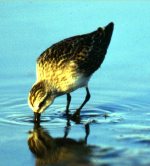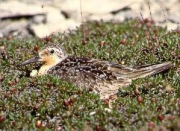| New Jersey Division of Fish and Wildlife |
| 2000
Arctic Search for the Red Knot About this Expedition |
| Led by the Division of Fish
and Wildlife's Endangered and
Nongame Species Program (ENSP) and the Royal Ontario Museum (ROM) in Toronto, a
19-day expedition to the Canadian Arctic searched for breeding red knots,
a species of shorebird that spends the month of May feeding on horseshoe
crab eggs on the shores of the Delaware Bay. Between Tuesday, June 27, and
July 15, ENSP biologists filed updates and photographs of their efforts.
These updates were made available on this Website as they were received.
The red knots, which winter in Tierra del Fuego at the southern tip of South America, essentially double their weight during their Delaware Bay stopover before embarking on a non-stop 2,000-mile flight to their breeding grounds on the edge of the Arctic north of Hudson Bay. The spectacle of tens of thousands of feeding shorebirds attracts numerous ecotourists and generates a multi-million dollar effect on the state and local economies. ENSP and the ROM are concerned that the commercial harvest of horseshoe
crabs for bait is reducing crab numbers and threatening the supply of crab
eggs that the red knots and other shorebirds, "If the crabs do decline, which we think is already happening, we want to establish some baseline data so that we will be able to have hard data concerning the impact of such a decline on the red knots," says Larry Niles, the chief of the ENSP, who is co-led the expedition with Mark Peck of ROM. "If the crabs fail, the possible consequences include some red knots failing to gain enough weight to make the flight to the breeding grounds. Others could get there late or fail to breed, and still others might not produce as many chicks." (Four eggs are normal.) Prior to last summer, no one had ever located nesting red knots from
the Western Hemisphere. But, within a matter of hours in July, 1999,
conducting an aerial survey of Southampton Island at the mouth Based on a statistical analysis, ENSP estimates that that area alone
potentially harbors 5,000 pairs, or 10,000 adult red knots -- one-sixth of
the estimate of red knots for the entire flyway. This year's expedition
goals are two-fold: The 14-person expedition includes 4 ENSP biologists, two ROM biologists and a videographer, a biologist from The Nature Conservancy, a U.S. Fish and Wildlife Service biologist, a Georgia Department of Natural Resources biologist, a Rutgers University ecologist, a graduate student from Argentina, an Inuit guide and U.S. educator who will establish a sister-school relationship between an Inuit school on Southampton Island and a southern New Jersey school. The expedition has been made possible by the following organizations and agencies:
We are especially grateful to Linda Tesauro (CWF), Bill Weber, Stacey Lowe (WCS), Lisa Garrison (Dodge), Mary Ann Young, Cliff Day, Annette Scherer, Steve Atzert, Greg Breese (USFWS), Allan Baker (ROM), John Bognar (CRSSA), Ron Porter (engineer), Ed Swayda (pilot) and Ramshorn Hoochie Girl (Knot pointer). The Endangered and Nongame species program receives no direct state funding. It is supported through the
wildlife check-off option on state income tax returns, the 'Conserve
Wildlife' license plate and other donations. |
 such as ruddy turnstones and
semi-palmated sandpipers, depend on. In order to determine what effects
such an egg decline might have on the red knots' ability to reproduce, the
14-person expedition located nests of some of the 140 red knots that had
lightweight radio transmitters attached to them during banding operations
on the Delaware Bay in May.
such as ruddy turnstones and
semi-palmated sandpipers, depend on. In order to determine what effects
such an egg decline might have on the red knots' ability to reproduce, the
14-person expedition located nests of some of the 140 red knots that had
lightweight radio transmitters attached to them during banding operations
on the Delaware Bay in May.
 of Hudson
Bay, the team located eight birds transmitting signals within a stretch of
2,500 square kilometers. Those eight were among 65 that had been outfitted
with transmitters months earlier on the Delaware Bay shores. One nest and
its female were ultimately located on the ground.
of Hudson
Bay, the team located eight birds transmitting signals within a stretch of
2,500 square kilometers. Those eight were among 65 that had been outfitted
with transmitters months earlier on the Delaware Bay shores. One nest and
its female were ultimately located on the ground.